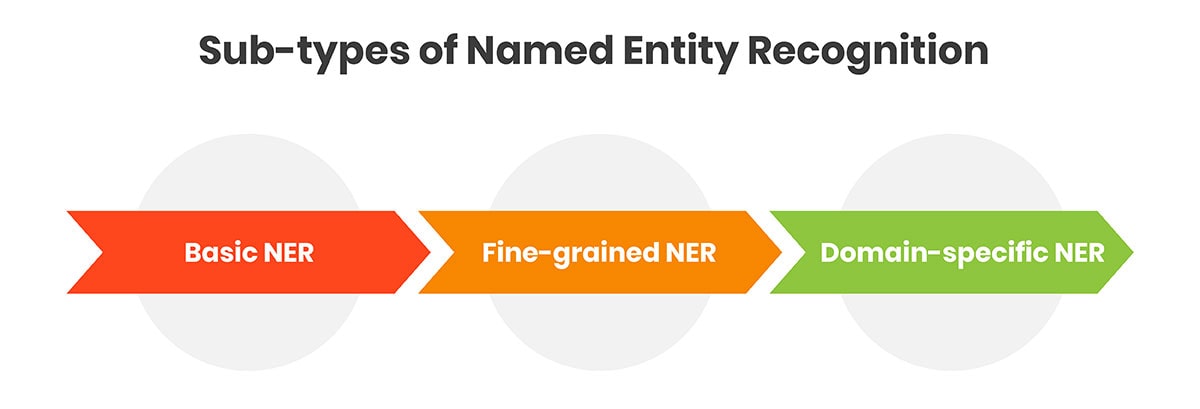Named Entity Recognition in NLTK: A Practical Guide

Named entity recognition (NER) is an important subtask of natural language processing (NLP) that aims to extract and categorize the entities contained in a text into predefined classes, such as names, organizations, and locations. This capability proves to be useful when attempting to identify relevant patterns from a mountain of data. Implementing NER can be done quite effectively using tools such as the Natural Language Toolkit (NLTK) as well as Spacy. While discussing NER, it is necessary to mention its subtypes, investigate NER with the help of NLTK and SpaCy, focus on the deep learning approach, and compare these tools to reveal their application perspectives and trends.
What is Named Entity Recognition?
Named entity recognition (NER) is a crucial task in natural language processing that involves identifying and classifying named entities in text into predefined categories. These entities can include:
- Persons (e.g., names of people)
- Organizations (e.g., company names)
- Locations (e.g., cities, countries)
- Dates and times
- Monetary values
NER plays a critical role in transforming text into useful information and can be used to solve tasks like information search, question answering, and classification of content. Therefore, knowledge of entities from the text is useful for structuring data, optimizing certain types of searches, as well as increasing the reliability of data analysis.
Sub-types of Named Entity Recognition
There are several sub-types of NER that are used for different tasks and provide different levels of detail. Identifying these sub-types is important when choosing the right method for a particular task in natural language processing (NLP).

1. Basic NER:
This is the most common form of NER, which identifies and classifies entities into predefined categories such as:
-
Persons (e.g., "Barack Obama")
-
Organizations (e.g., "Google")
-
Locations (e.g., "New York")
Basic NER is useful for general text-processing tasks where a broad categorization of entities is sufficient.
2. Fine-grained NER:
Unlike basic NER, fine-grained NER classifies entities into more specific sub-categories. For example:
-
Persons: politicians, actors, athletes
-
Organizations: companies, non-profits, government bodies
-
Locations: cities, countries, landmarks
This level of detail is particularly valuable in specialized domains where precise entity classification enhances information extraction and analysis.
3. Domain-specific NER:
Tailored for specific industries or fields, domain-specific NER models are trained on specialized datasets to recognize entities unique to that domain. Examples include:
-
Biomedical NER: genes, proteins, diseases
-
Financial NER: stock symbols, financial instruments, economic indicators
Such models provide high accuracy and relevance in their respective domains, making them indispensable for industry-specific applications.
All sub-types of named entity recognition maintain their unique benefits given the specifics of the kind of detail needed for an application. Therefore, according to the chosen NER sub-type, the practitioners can gain a notable improvement in the effectiveness and applicability of the subsequent NLP system.
Named Entity Recognition in NLTK
Named entity recognition (NER) is an essential part of natural language processing (NLP) that helps to identify particular entities, including names, organizations, and locations within the text. The Natural Language Toolkit (NLTK) is a popular library in Python for NLP and is used for NER among other applications. In this case, we discuss how to apply NER using NLTK, describe the process, and point out its strengths and weaknesses.
Introduction to NLTK for NER
NLTK is a comprehensive library that provides easy-to-use interfaces to over 50 corpora and lexical resources. It includes various tools for text processing, such as tokenization, tagging, and parsing, making it a go-to library for NLP tasks.
Steps to Perform NER with NLTK
1. Import Necessary Libraries: Begin by importing the essential libraries and modules for NER.
CODE SNIPPET:
import nltk
from nltk import word_tokenize, pos_tag, ne_chunk
nltk.download('punkt')
nltk.download('maxent_ne_chunker')
nltk.download('words')
2. Preprocess the text: Tokenization and part-of-speech (POS) tagging are required before NER.
CODE SNIPPET:
sentence = "Apple is looking at buying U.K. startup for $1 billion."
tokens = word_tokenize(sentence)
pos_tags = pos_tag(tokens)
3. Apply NLTK’s NER tagger: Use ‘ne_chunk’ to identify named entities in the text.
CODE SNIPPET:
named_entities = ne_chunk(pos_tags)
print(named_entities)
Example Code Snippet
Here’s a complete example demonstrating NER with NLTK:
import nltk
from nltk import word_tokenize, pos_tag, ne_chunk
# Download necessary resources
nltk.download('punkt')
nltk.download('maxent_ne_chunker')
nltk.download('words')
# Sample sentence
sentence = "Apple is looking at buying U.K. startup for $1 billion."
# Tokenize and POS tag
tokens = word_tokenize(sentence)
pos_tags = pos_tag(tokens)
# Perform NER
named_entities = ne_chunk(pos_tags)
print(named_entities)
Advantages of Using NLTK for NER
NLTK offers several benefits for performing named entity recognition (NER), making it a valuable tool for NLP tasks:
-
Comprehensive Library: NLTK is a vast library that includes over fifty corpora and lexical resources used in NLP.
-
Ease of Use: The simple and easy-to-use API makes it easier for developers and researchers to start using NER and test it without having to go through a lengthy process of setting up the system.
-
Educational Value: It is a powerful tool for learning and teaching NLTK, which provides a rich set of documentation and examples, allowing users to gain a good understanding of the principles of NLP.
Limitations of Using NLTK for NER
While NLTK is a powerful tool for natural language processing, it has several limitations when it comes to named entity recognition:
-
Performance: NLTK uses classical machine learning methods for NER which may not be as accurate as deep learning methods. This means that the precision and recall rates in entity identification will be lower.
-
Scalability: NLTK can be less efficient when dealing with big data and high-performance applications, thus it is not ideal for use in production environments that demand real-time processing.
-
Flexibility: The library does not provide as many configuration and tuning parameters as more sophisticated libraries such as SpaCy; that allow users to define their pipelines and models.
Deep Learning Approaches to Named Entity Recognition
Deep learning approaches to NER utilize neural networks to learn the features and patterns that are required to identify entities almost autonomously. This results in a marked increase in efficiency as compared to the use of traditional machine learning tools.
1. Recurrent Neural Networks (RNNs)
-
Overview: Since RNNs are proposed for use with sequential data the use of text was fitting because of the sequential nature of language. They keep track of a hidden state that contains information from preceding words and helps with entities.
-
Limitations: The standard RNNs have problems with handling long-time dependencies because of the vanishing gradient problem and it is hard to capture long context in long sentences.
2. Long Short-Term Memory Networks (LSTMs)
-
Overview: LSTMs are a subcategory of RNN that is created to avoid the problems of standard RNN models due to the presence of gates. This makes it easier for LSTMs to capture long-range dependencies as compared to the standard RNNs.
-
Advantages: Long Short-Term Memory Networks have reported marked enhancements in NER tasks because of their capability to recall important information over longer sequences.
3. Transformers (e. g., BERT)
-
Overview: Some recent models such as the BERT models have impacted NER through their attentions that make the model focus on the whole word in the sentence.
-
Performance: Recent algorithms like BERT and other models have introduced new state-of-the-art results in NER, with the help of large pre-trained models retrained concerning specific tasks.
Comparison with Traditional Methods
-
Accuracy: The transformer models, specifically the deep learning models, are better, more efficient than the previous methods, and yield high accuracy in entity recognition tasks.
-
Training Data: Deep learning techniques are superior but have the drawback of needing large quantities of training data that are tagged, which is a disadvantage but results in improved generalization.
-
Computation: These models are complex to train and need a significant system’s resources and are time-consuming as well.
Deep learning techniques have revolutionized several fields including named entity recognition which has gained a strong solution that is rich in various languages and domains.
Examples of Frameworks and Libraries for Deep Learning-based NER
Deep learning in named entity recognition has brought significant improvement in performance capacity and flexibility. Several frameworks and libraries facilitate deep learning-based NER:
1. TensorFlow and Keras
TensorFlow is a popular deep learning framework, and Keras, its high-level API, simplifies model building and training.
CODE SNIPPET:
import tensorflow as tf
from tensorflow.keras.layers import LSTM, Embedding, Dense, TimeDistributed, Dropout, Bidirectional
from tensorflow.keras.models import Sequential
model = Sequential()
model.add(Embedding(input_dim=vocab_size, output_dim=embedding_dim, input_length=max_len))
model.add(Bidirectional(LSTM(units=100, return_sequences=True, recurrent_dropout=0.2)))
model.add(TimeDistributed(Dense(units=num_classes, activation="softmax")))
model.compile(optimizer="adam", loss="categorical_crossentropy", metrics=["accuracy"])
2. PyTorch
PyTorch is another leading deep learning library known for its dynamic computation graph and ease of use.
CODE SNIPPET:
import torch
import torch.nn as nn
from torchcrf import CRF
class NERModel(nn.Module):
def __init__(self, vocab_size, tagset_size, embedding_dim, hidden_dim):
super(NERModel, self).__init__()
self.embedding = nn.Embedding(vocab_size, embedding_dim)
self.lstm = nn.LSTM(embedding_dim, hidden_dim, bidirectional=True)
self.hidden2tag = nn.Linear(hidden_dim*2, tagset_size)
self.crf = CRF(tagset_size, batch_first=True)
def forward(self, sentence):
embeds = self.embedding(sentence)
lstm_out, _ = self.lstm(embeds)
emissions = self.hidden2tag(lstm_out)
return emissions
3. SpaCy
SpaCy is a robust NLP library with built-in deep-learning models for NER.
CODE SNIPPET:
import spacy
nlp = spacy.load("en_core_web_sm")
doc = nlp("Apple is looking at buying U.K. startup for $1 billion.")
for ent in doc.ents:
print(ent.text, ent.label_)
These frameworks and libraries provide strong tools for composing, training, and applying deep learning methods for NER, all of which contain different features that can be preferable for various stakeholders in NLP.
Integrating NER with Other NLP Tasks
NER can be easily combined with other NLP tasks to improve text analysis and information extraction from text. Thus, using NER together with sentiment analysis, text classification, and information retrieval, it is possible to obtain a more balanced picture of the textual data.
Example: Combining NER with Sentiment Analysis
-
1. Extract Named Entities: Use NER to identify entities in the text.
-
2. Perform Sentiment Analysis: Analyze the sentiment of sentences containing named entities.
-
3. Aggregate Results: Combine the results to understand the sentiment towards specific entities.
CODE SNIPPET:
Here’s an example demonstrating the integration of NER with sentiment analysis using NLTK and TextBlob:
import nltk
from nltk import word_tokenize, pos_tag, ne_chunk
from textblob import TextBlob
# Download necessary resources
nltk.download('punkt')
nltk.download('maxent_ne_chunker')
nltk.download('words')
# Sample sentence
sentence = "Apple is looking at buying U.K. startup for $1 billion. The news is very exciting."
# Tokenize and POS tag
tokens = word_tokenize(sentence)
pos_tags = pos_tag(tokens)
# Perform NER
named_entities = ne_chunk(pos_tags)
# Perform Sentiment Analysis
blob = TextBlob(sentence)
sentiment = blob.sentiment
# Print results
print("Named Entities:", named_entities)
print("Sentiment Analysis:", sentiment)
This integration enables a better understanding of how entities are recognized within a specific text, demonstrating the effectiveness of employing NER along with other NLP tasks.
Practical Applications of Named Entity Recognition
NER has its application across many industries through the improvement of data analysis and information extraction. Here are some key practical applications:
-
1. Finance
It is applied to identify important financial entities including corporations’ names, stock codes, and monetary terms from news articles, reports, and financial statements. This assists in the automation of monitoring market trends, the sentiment of products or services, and fraud detection.
-
2. Healthcare
NER plays a critical role in the healthcare industry to recognize medical phrases including drugs, diseases, and patients’ information in clinical documents, research articles, and electronic health records. This allows for better data handling, clinical decision-making, and research findings.
-
3. E-commerce
For e-commerce, NER can extract product names, brands, and other important features from user reviews and product descriptions. This improves the search, recommendation, and customer service bots that are integrated into the application.
-
4. Legal Industry
NER is used on legal documents to get important entities such as the names of cases, legislation, and courts. This helps in the management of documents, research on legal matters, and the analysis of contracts.
These applications show how named entity recognition can help to enhance productivity and optimize various industries. Thus, organizations can extract useful information from unstructured text, which in turn, results in better decision-making and improved organizational performance.
Conclusion
Named entity recognition (NER) is a crucial component of natural language processing since it helps in identifying entities of interest within a given text. NLTK is a suitable tool for NER, which is best used for teaching purposes and in small-scale projects. Although it provides a set of tools for general NER tasks, the issues of its performance and scalability prove that the further development of deep learning methods is beneficial. Therefore, the utilization of the different libraries is beneficial in improving NER and its use.







